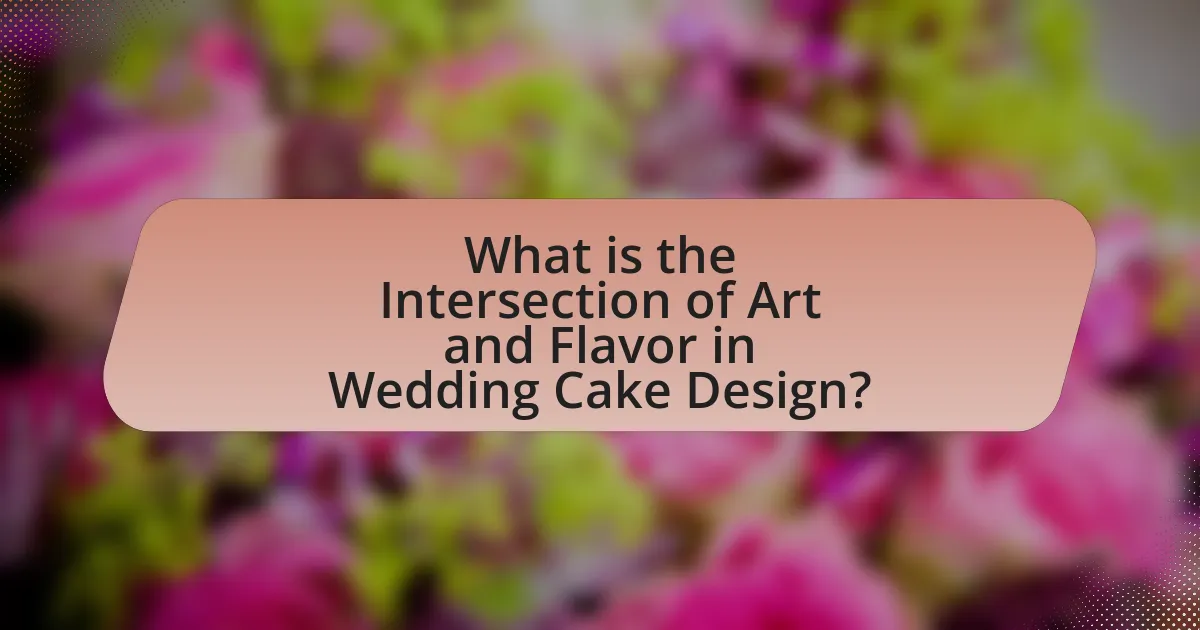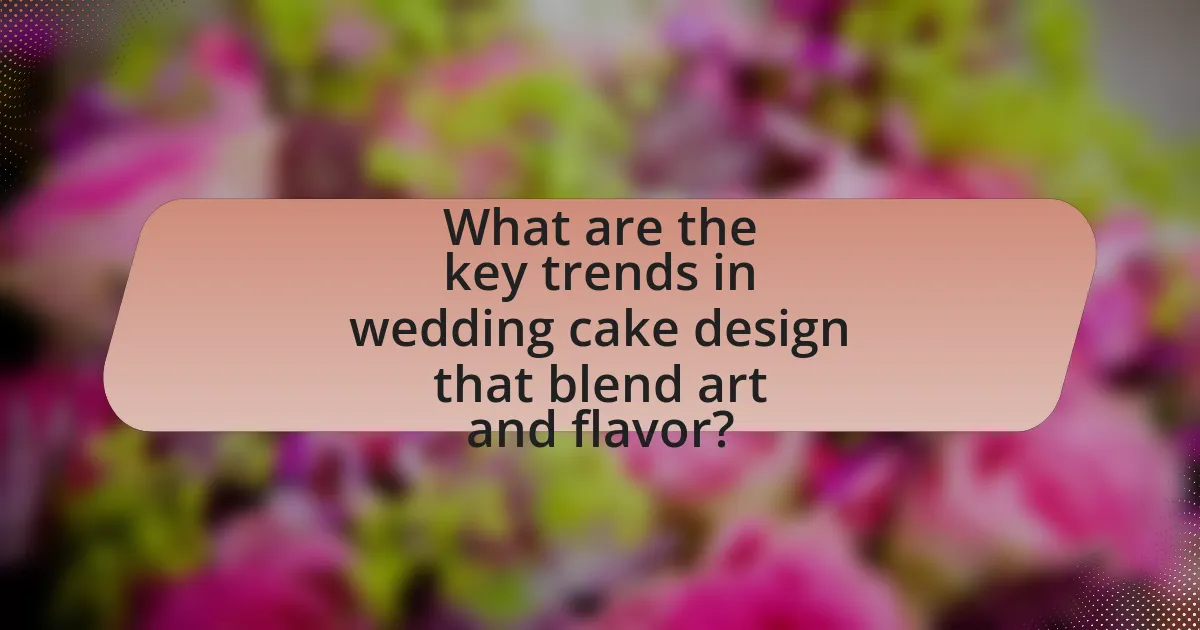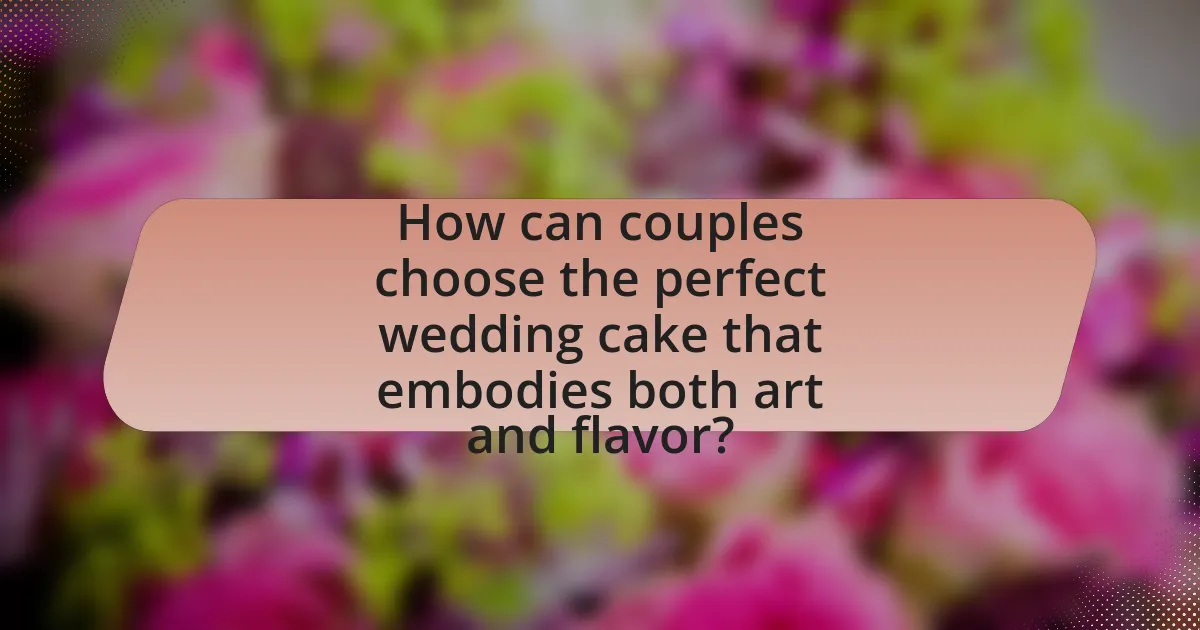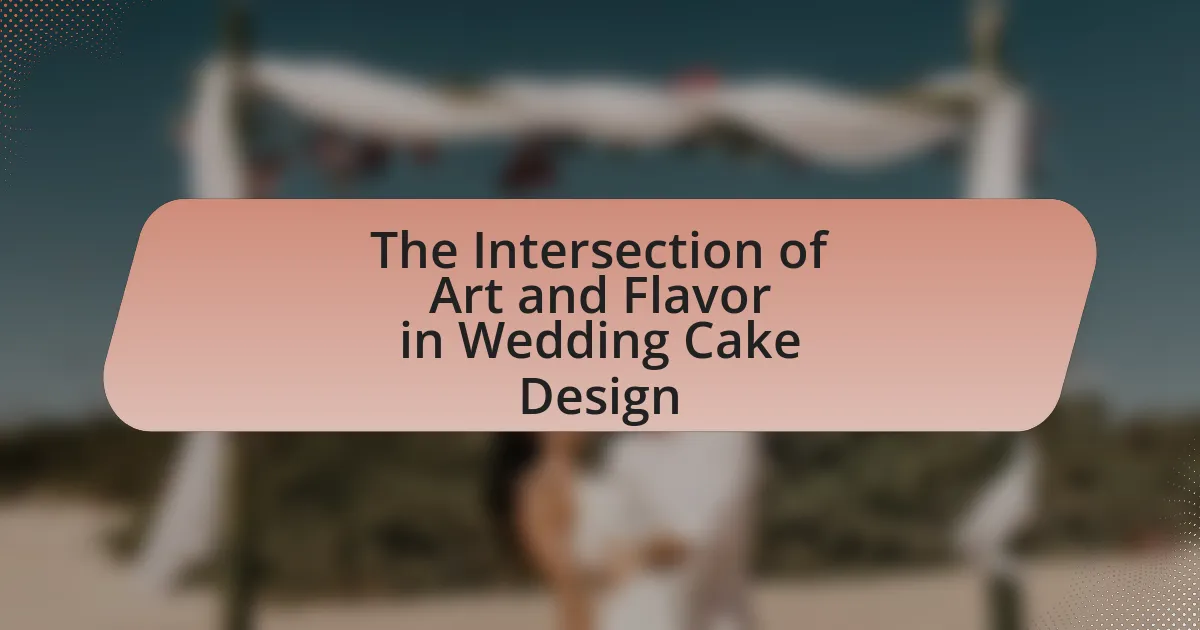The article explores the intersection of art and flavor in wedding cake design, emphasizing the importance of both aesthetic presentation and taste experience. It discusses how artistic elements, such as intricate decorations and personalized designs, reflect the couple’s personality while flavor choices cater to diverse palates. Key trends in modern wedding cakes, including bold colors and unique flavor combinations, are highlighted, along with the influence of cultural traditions on cake design. The article also addresses the significance of balancing art and flavor to enhance guest satisfaction and provides practical tips for couples in selecting their ideal wedding cake.

What is the Intersection of Art and Flavor in Wedding Cake Design?
The intersection of art and flavor in wedding cake design lies in the harmonious blend of aesthetic presentation and taste experience. Wedding cakes are crafted not only to be visually stunning, often featuring intricate designs, colors, and themes that reflect the couple’s personality, but they also prioritize flavor profiles that cater to diverse palates. For instance, a cake may be adorned with artistic sugar flowers or fondant decorations while incorporating rich flavors like chocolate ganache or zesty lemon curd, ensuring that the visual appeal complements the sensory enjoyment. This dual focus on artistry and flavor is essential, as studies show that the overall satisfaction of wedding cake consumption is significantly influenced by both its appearance and taste, making it a critical element of the wedding celebration.
How do art and flavor influence wedding cake design?
Art and flavor significantly influence wedding cake design by shaping both the visual appeal and the taste experience of the cake. The artistic elements, such as color, texture, and decoration, create a visual representation of the couple’s style and theme, while the flavor choices cater to the preferences of the couple and their guests. For instance, a cake designed with intricate sugar flowers and elegant fondant may reflect a classic or romantic theme, while flavors like chocolate ganache or lemon zest can enhance the overall enjoyment and satisfaction of the cake. Research indicates that visual aesthetics can enhance perceived flavor, meaning that a beautifully designed cake can make flavors seem more appealing, thus reinforcing the importance of both art and flavor in wedding cake design.
What artistic elements are commonly incorporated into wedding cakes?
Wedding cakes commonly incorporate artistic elements such as intricate fondant designs, hand-painted decorations, sugar flowers, and personalized cake toppers. These elements enhance the visual appeal and reflect the couple’s style and theme. For instance, fondant allows for smooth finishes and detailed designs, while sugar flowers can be crafted to mimic real blooms, adding a lifelike touch. Hand-painted decorations can include custom artwork or patterns that resonate with the wedding’s aesthetic, making each cake unique. Personalized cake toppers often feature the couple’s initials or a meaningful symbol, further customizing the cake to their story.
How do flavor choices impact the overall design of a wedding cake?
Flavor choices significantly impact the overall design of a wedding cake by influencing its aesthetic presentation and structural integrity. For instance, popular flavors like vanilla or chocolate often lead to classic designs, while unique flavors such as lavender or matcha can inspire more creative and unconventional decorations. Additionally, the choice of flavor affects the type of frosting and filling used, which in turn determines the cake’s texture and visual appeal. Cakes with fruit fillings may require additional support structures to maintain their shape, while denser flavors can allow for more intricate designs. Therefore, the interplay between flavor and design is crucial in creating a wedding cake that is both visually stunning and delicious.
Why is the balance between art and flavor important in wedding cakes?
The balance between art and flavor in wedding cakes is crucial because it ensures that the cake is not only visually appealing but also delicious, enhancing the overall experience of the celebration. A wedding cake serves as a centerpiece and symbol of the event, making its aesthetic design important for visual impact; however, if the cake lacks flavor, it can disappoint guests and detract from the joy of the occasion. Studies show that 70% of guests remember the taste of the wedding cake, indicating that flavor significantly influences their overall impression of the event. Therefore, achieving a harmonious blend of artistic design and delightful taste is essential for creating a memorable wedding experience.
What are the consequences of prioritizing art over flavor?
Prioritizing art over flavor in wedding cake design can lead to a decline in customer satisfaction and overall enjoyment of the cake. When aesthetic appeal is emphasized excessively, the taste may be compromised, resulting in cakes that look beautiful but lack desirable flavors or textures. For instance, a study by the University of Florida found that consumers often associate flavor quality with visual presentation; however, if the flavor does not meet expectations, it can lead to disappointment, regardless of the cake’s artistic design. This imbalance can ultimately affect the reputation of the cake designer and the overall experience of the wedding, as guests may remember the cake more for its lack of flavor than its visual appeal.
How can flavor enhance the visual appeal of a wedding cake?
Flavor can enhance the visual appeal of a wedding cake by influencing the choice of colors, decorations, and overall design theme. When bakers select flavors that evoke specific colors, such as vibrant raspberry or rich chocolate, they can create visually striking cakes that reflect the taste experience. For instance, a lemon-flavored cake can be adorned with bright yellow fondant and fresh lemon slices, enhancing both the visual and sensory appeal. Additionally, flavor profiles can inspire artistic elements like floral designs or themed decorations, making the cake not only a treat for the palate but also a centerpiece that captivates guests. This connection between flavor and visual design is supported by culinary trends that emphasize the importance of aesthetic presentation in food, as seen in events like cake competitions where judges evaluate both taste and appearance.

What are the key trends in wedding cake design that blend art and flavor?
Key trends in wedding cake design that blend art and flavor include the use of bold colors, intricate textures, and unique flavor combinations. Bold colors, such as deep blues and vibrant greens, are increasingly popular, allowing cakes to serve as striking centerpieces. Intricate textures, achieved through techniques like ruffles and geometric patterns, enhance visual appeal while adding depth. Unique flavor combinations, such as lavender and lemon or chocolate and chili, cater to diverse palates and elevate the tasting experience. These trends reflect a growing emphasis on personalization and creativity in wedding cake design, aligning aesthetic beauty with culinary innovation.
How have modern wedding cake designs evolved in terms of artistic expression?
Modern wedding cake designs have evolved significantly in terms of artistic expression by incorporating diverse styles, innovative techniques, and personalized themes. Contemporary cake artists now utilize fondant, edible paints, and intricate piping to create visually stunning pieces that reflect individual couple’s stories and aesthetics. For instance, the trend of using geometric shapes and metallic finishes has emerged, showcasing a shift from traditional tiered cakes to more sculptural forms. Additionally, the rise of social media platforms has influenced cake design, as artists are inspired by global trends and share their creations widely, leading to a fusion of cultural elements in cake artistry. This evolution is evident in the increasing popularity of unique flavors and textures, which complement the visual artistry, making modern wedding cakes not only a centerpiece but also a personalized culinary experience.
What innovative techniques are being used to combine flavors and aesthetics?
Innovative techniques used to combine flavors and aesthetics in wedding cake design include the use of flavor layering, edible flowers, and modern plating techniques. Flavor layering involves incorporating multiple flavor profiles within a single cake, allowing for a complex taste experience that complements the visual design. Edible flowers not only enhance the aesthetic appeal but also contribute unique flavors, creating a harmonious blend of taste and beauty. Modern plating techniques, such as the use of geometric shapes and vibrant color contrasts, elevate the presentation, making the cake a centerpiece that engages both the palate and the eyes. These methods reflect a growing trend in culinary art where visual and gustatory elements are intricately linked, enhancing the overall experience of wedding cakes.
Which flavor profiles are currently popular in wedding cakes?
Currently, popular flavor profiles in wedding cakes include vanilla bean, chocolate ganache, lemon zest, and red velvet. These flavors have gained traction due to their versatility and appeal to a wide range of palates. Vanilla bean is favored for its classic taste, while chocolate ganache offers a rich, indulgent experience. Lemon zest provides a refreshing citrus note, and red velvet is celebrated for its unique color and mild cocoa flavor. According to industry surveys, these flavors consistently rank among the top choices for couples planning their weddings, reflecting current trends in cake design and flavor preferences.
What role do cultural influences play in the art and flavor of wedding cakes?
Cultural influences significantly shape both the art and flavor of wedding cakes. Different cultures bring unique traditions, ingredients, and aesthetic preferences to cake design, resulting in diverse styles and flavors. For instance, in Italian weddings, the traditional millefoglie cake features layers of puff pastry and cream, reflecting regional culinary practices. In contrast, a classic American wedding cake often consists of multiple tiers with buttercream frosting, showcasing a different artistic approach. Additionally, cultural symbolism plays a role; for example, red velvet cake is popular in some Southern U.S. weddings, symbolizing love and passion. These variations illustrate how cultural backgrounds inform the choices of flavors, designs, and even the rituals surrounding wedding cakes, making them a reflection of the couple’s heritage and personal tastes.
How do different cultures express their traditions through wedding cake design?
Different cultures express their traditions through wedding cake design by incorporating unique ingredients, shapes, colors, and symbolic decorations that reflect their heritage. For instance, in Italian weddings, the traditional Millefoglie cake features layers of puff pastry and cream, symbolizing the layers of love and commitment. In contrast, Indian weddings often showcase multi-tiered cakes adorned with intricate designs and vibrant colors, representing the celebratory nature of the event and the couple’s cultural background. Additionally, in Japanese weddings, the Shirozukuri cake, made from rice flour, is often decorated with seasonal flowers, symbolizing purity and the beauty of nature. These specific designs and ingredients not only enhance the visual appeal of the cake but also serve as a representation of the couple’s cultural identity and familial traditions.
What unique flavors are associated with specific cultural wedding cakes?
Unique flavors associated with specific cultural wedding cakes include almond in Italian wedding cakes, red bean in Chinese wedding cakes, and saffron in Indian wedding cakes. Italian wedding cakes often feature a rich almond flavor, reflecting traditional Italian ingredients and customs. Chinese wedding cakes, known as “cake of happiness,” typically incorporate red bean paste, symbolizing good fortune and prosperity. Indian wedding cakes frequently use saffron, which is prized for its flavor and color, representing purity and wealth in Indian culture. These flavors not only enhance the taste but also carry significant cultural meanings, making them integral to the wedding celebrations.

How can couples choose the perfect wedding cake that embodies both art and flavor?
Couples can choose the perfect wedding cake that embodies both art and flavor by selecting a design that reflects their personal style while also considering taste preferences. To achieve this, couples should first identify their wedding theme and colors, which will guide the artistic elements of the cake design. Next, they should schedule tastings with various bakers to explore flavor combinations that appeal to them, ensuring that the cake is not only visually stunning but also delicious. Research indicates that 70% of couples prioritize flavor alongside aesthetics when selecting their wedding cake, highlighting the importance of balancing both aspects. By collaborating with a skilled baker who understands their vision and can incorporate unique flavors, couples can create a cake that is both a work of art and a delightful treat for their guests.
What factors should couples consider when selecting a wedding cake designer?
Couples should consider the designer’s portfolio, flavor options, customization capabilities, and reviews when selecting a wedding cake designer. A designer’s portfolio showcases their artistic style and previous work, helping couples assess if their vision aligns with the designer’s expertise. Flavor options are crucial, as couples should ensure the designer offers a variety of tastes that appeal to them and their guests. Customization capabilities allow couples to create a unique cake that reflects their personality and wedding theme. Lastly, reviews and testimonials provide insight into the designer’s reliability and quality of service, which is essential for ensuring a smooth experience on the wedding day.
How can couples communicate their vision for art and flavor to their cake designer?
Couples can effectively communicate their vision for art and flavor to their cake designer by providing a detailed brief that includes visual references and flavor preferences. This can involve sharing images of cakes that resonate with their aesthetic, discussing color palettes, and specifying any themes or styles they envision, such as rustic, modern, or classic. Additionally, couples should articulate their flavor preferences, including favorite cake types, fillings, and any dietary restrictions. Clear communication ensures that the cake designer understands the couple’s desires, leading to a final product that aligns with their vision.
What questions should couples ask to ensure a balance of art and flavor?
Couples should ask questions that address both aesthetic appeal and taste preferences to ensure a balance of art and flavor in wedding cake design. Key questions include: “What flavors do we both enjoy?” to identify preferred tastes, “How do we want the cake to look?” to establish artistic vision, and “Can we incorporate personal elements into the design?” to enhance uniqueness. Additionally, asking “What are the latest trends in cake design?” can provide inspiration while ensuring the cake remains contemporary. These questions facilitate a collaborative approach, ensuring that both the visual and taste aspects of the cake meet the couple’s expectations.
What are some practical tips for achieving a harmonious blend of art and flavor in wedding cakes?
To achieve a harmonious blend of art and flavor in wedding cakes, focus on selecting complementary flavors that enhance the visual design. For instance, pairing a rich chocolate cake with a light raspberry filling not only provides a delightful taste experience but also creates a visually appealing contrast. Additionally, incorporating natural colors from ingredients like fruits or edible flowers can enhance the cake’s aesthetic while maintaining flavor integrity. Using high-quality ingredients ensures that both the taste and appearance meet high standards, as fresh, organic components often yield better flavor profiles and vibrant colors. Finally, consider the overall theme of the wedding; aligning the cake’s design and flavor with the event’s color palette and style can create a cohesive and memorable experience for guests.
How can couples sample flavors while considering artistic designs?
Couples can sample flavors while considering artistic designs by selecting cake tastings that showcase both taste and visual appeal. This can be achieved by collaborating with a baker who specializes in custom wedding cakes, allowing couples to choose flavors that complement the cake’s design. For instance, a baker might offer a tasting menu that includes flavors like vanilla bean paired with a floral design or rich chocolate with geometric patterns. Research indicates that visual aesthetics significantly influence taste perception, meaning that an appealing design can enhance the overall flavor experience. Therefore, couples should prioritize bakers who can provide samples that reflect their desired artistic vision while also delivering on flavor quality.
What are common pitfalls to avoid when designing a wedding cake?
Common pitfalls to avoid when designing a wedding cake include neglecting flavor balance, overlooking structural integrity, and failing to consider the wedding theme. Neglecting flavor balance can lead to a cake that looks beautiful but tastes unappealing, as flavor should complement the visual design. Overlooking structural integrity can result in a cake that collapses or cannot support its own weight, especially with multiple tiers; using appropriate support systems is essential. Failing to consider the wedding theme can lead to a cake that feels out of place, as the design should reflect the couple’s style and the overall aesthetic of the event.
